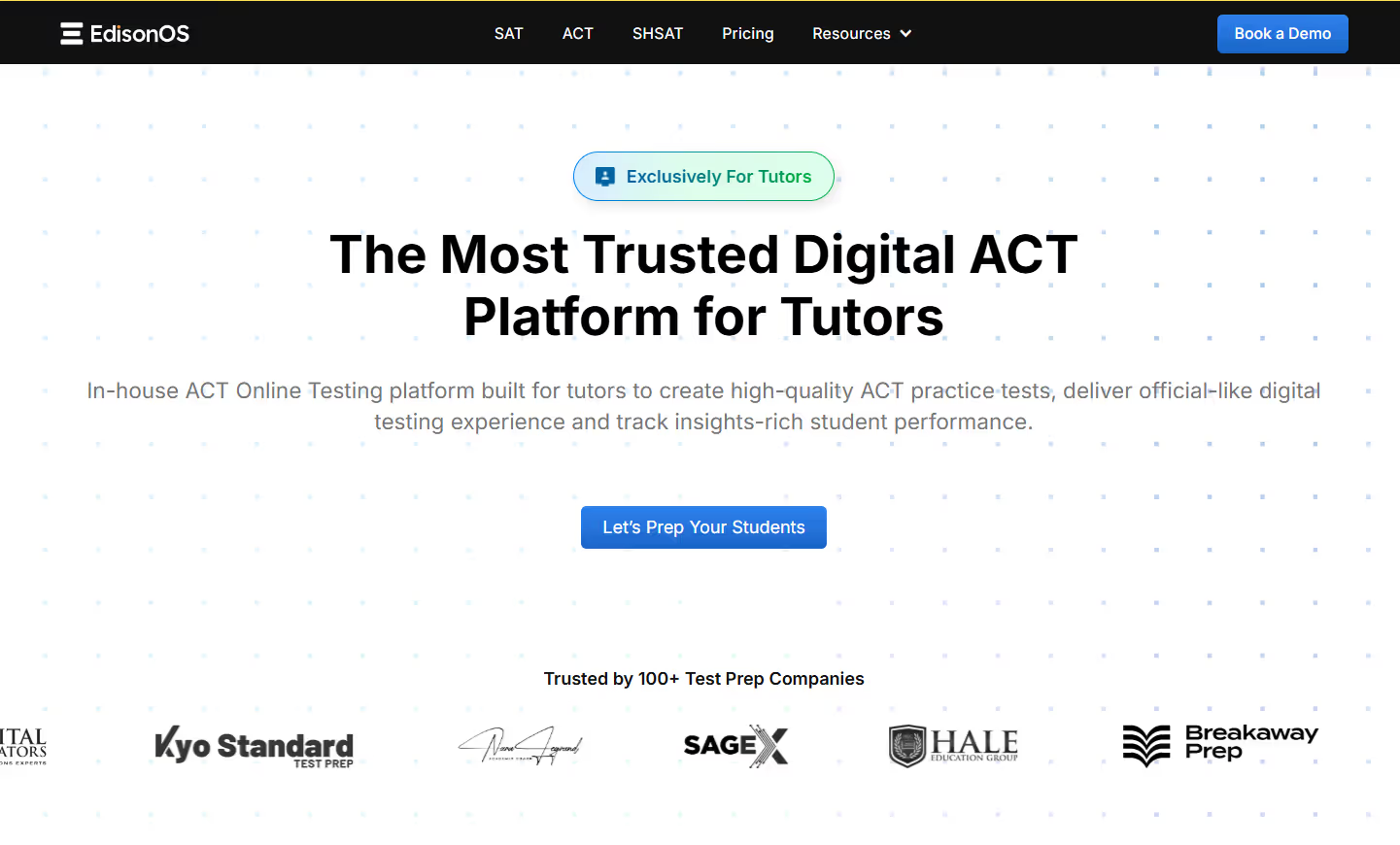




Key Takeaways
- Students can skip sections and focus only on what’s required by target colleges.
- New scoring reflects only completed sections, allowing strengths to shine.
- Enhanced ACT offers digital format, shorter test time, and more flexible prep strategies.
The ACT is changing in 2025. The new “enhanced ACT” is an updated version of the exam that adds more choice and flexibility for test-takers. It allows students to pick which sections matter to them, making it a more tailored and less daunting experience.
Why does this matter? Because it gives students more control over how they show their skills—and it could impact how they prepare, how they test, and how they stand out in the college admissions process.
In short, if you’re planning to take the ACT in 2025 or later, you need to understand these changes now.
What’s new in the enhanced ACT?
The Enhanced ACT introduces a smarter, more flexible approach to testing. It’s built to match how students learn today—and it gives them more control over their experience.
Key changes in test format
The Enhanced ACT introduces structural and delivery changes designed to reduce stress while maintaining rigor.
- Shorter & Faster: The test is about 75 minutes shorter, with 44 fewer questions overall, giving students more time per question
- Optional Sections: Science and Writing are optional, allowing students to focus on core subjects
- Digital First: The ACT is primarily delivered digitally, though paper testing is still offered
- Math Format Update: Math questions now have four answer choices instead of five
- Reading Passages: Passages are shorter to reduce mental fatigue
- Embedded Questions: Unscored experimental questions are embedded within sections instead of appearing as a separate test section
Subject section comparison: regular ACT vs. enhanced ACT
Here’s a quick comparison to help you see how the two versions differ in terms of section requirements and delivery method:
Each section has been tightened and refined. The questions are designed to measure understanding, critical thinking, and problem-solving rather than rewarding sheer memorization.
- Math: Expect questions that test how well you apply math concepts in everyday or academic settings, focusing more on reasoning and precision.
- Reading: The reading section emphasizes understanding and analyzing complex texts. Passages are shorter, making it less about speed and more about comprehension.
- Science: The Science section now focuses more sharply on interpreting data and understanding scientific concepts, making it closer to how you’ll use these skills in college courses.
- Writing (Optional): The essay remains optional, giving students a chance to showcase their ability to build an argument and write clearly — an important skill for many fields of study.
What Stays the Same
Despite these changes, several core elements of the ACT remain unchanged.
- Content: The skills and knowledge tested remain consistent with previous ACT versions
- Scoring Scale: Scores are still reported on a 1–36 scale
- Superscoring: Superscoring is still supported (college policies differ)
- Test Formats: Both digital and paper-based tests continue to be available
Why the ACT Is Changing
The Enhanced ACT reflects broader shifts in education and assessment.
- To reduce test fatigue caused by long exams
- To give students more flexibility and control over how they test
- To better align with digital-first learning environments
- To stay competitive with the fully digital SAT
These changes aim to make the ACT more student-centered without compromising its role in college admissions.
When Did the Enhanced ACT Roll Out?
- United States: Digital testing began in April 2025
- International: Digital testing began in September 2025
- Paper Testing: Was available starting September 2025
How Scoring Works in the Enhanced ACT
The Enhanced ACT introduces a more flexible scoring structure.
- The composite score is calculated using English, Math, and Reading only
- Science and Writing are reported separately if taken
- Scores remain on the 1–36 scale
- Superscoring allows students to combine their best section scores across multiple test dates
For example:
- A student taking English, Math, and Reading with scores of 32, 30, and 28 would have a composite of 30
- A student who skips Science is not penalized for doing so
This system allows students to highlight strengths instead of being weighed down by sections that may not matter for their intended major.
Regular ACT English vs. Enhanced ACT English
Regular ACT English: The traditional test focused heavily on grammar, punctuation, and usage, making up roughly 55% of the questions. Another 32% tested production of writing (organization, unity, and cohesion) while about 13% targeted knowledge of language (style, tone, and vocabulary).
Total: 45 minutes, 75 questions.
Enhanced ACT English: The new version is shorter and more balanced. It still evaluates grammar and usage, but gives more weight to production of writing and knowledge of language, making these sections roughly equal in focus. Students have less total time but must be just as sharp across both areas.
Total: 35 minutes, 50 questions (plus ~10 field-test questions not scored).
Regular ACT Math vs. Enhanced ACT Math
Regular ACT Math: The traditional test covered algebra, geometry, and some trigonometry, with an emphasis on procedural fluency and problem-solving. Students had to work quickly to complete all questions.
Total: 60 minutes, 60 questions.
Enhanced ACT Math: The new version is slightly shorter and focuses more on applying math to real-world scenarios. It still covers algebra, geometry, functions, and statistics/probability, but includes more context-driven questions.Total: 50 minutes, 45 questions (plus ~4 field-test questions not scored).
Regular ACT Reading vs. Enhanced ACT Reading
Regular ACT Reading: The traditional test featured four passages (literary narrative, social science, humanities, and natural science) with ten questions per passage. It emphasized comprehension, inference, and reasoning under tight time constraints.
Total: 35 minutes, 40 questions.
Enhanced ACT Reading: The updated version allows more time per passage by slightly reducing the number of questions. It still emphasizes comprehension and inference, but also encourages deeper analysis and synthesis of ideas across the text.Total: 40 minutes, 36 questions (plus ~9 field-test questions not scored).
Regular ACT Science vs. Enhanced ACT Science
Regular ACT Science: This section required students to answer 40 questions in 35 minutes. It tested critical thinking, data interpretation, experimental design, and the evaluation of scientific models — not specific scientific knowledge.
Total: 35 minutes, 40 questions.
Enhanced ACT Science: Science is now an optional section. The format and focus remain largely the same — interpreting data and analyzing experiments — but students have more time, making it a better fit for those applying to science-focused programs.
Total (if taken): 40 minutes, 40 questions (plus ~6 field-test questions not scored).
Here’s a quick overview of the difference in each section:
The Impact of the enhanced ACT on student performance & preparation
The enhanced ACT doesn’t just change how the test looks, but also how it changes how students prepare and perform. Here’s how it affects students and tutors:
For Students
- Less fatigue due to a shorter test
- Ability to focus on strengths
- More strategic preparation and retesting
- Reduced pressure on test day
For Tutors and Educators
- Clearer diagnostic targets
- Section-specific retesting strategies
- Better alignment between prep and college requirements
- Increased importance of early diagnostics
How the enhanced ACT reflects educational trends & admission needs
- Rise of digital-first testing: Similar to the digital SAT, more colleges and students are embracing tech-driven assessment tools.
- Growth of skill-based evaluation: Colleges are looking beyond raw scores and favoring a student’s best performance across multiple tries (superscoring).
- Need for flexibility in test prep: With busy school schedules, students benefit from retesting specific sections instead of starting over.
- Increased use of diagnostic tools: Tools like ACT diagnostic tests help students zero in on areas for growth, supporting the test's more tailored design.
This new approach makes the ACT more student-friendly, performance-driven, and better aligned with modern college admissions priorities.
How to prepare for the enhanced ACT
The enhanced ACT may be more flexible, but it still requires thoughtful, focused preparation. Here’s how students can approach the updated format with confidence and clarity:
Test prep strategies for the new ACT format
- Focus on required sections first: Prioritize English, Math, and Reading before spending time on optional Science and Writing unless a target college requires them.
- Use section-specific practice: Instead of general study, focus on one section at a time, especially for superscoring.
- Time yourself with real test conditions: Simulate exam day by using a timer and eliminating distractions during practice.
- Retest with a purpose: Plan retakes based on where you scored lowest, not just for a full reset. This approach fits well with the Enhanced ACT model.
Recommended practice tests & materials for the enhanced ACT
EdisonOS: All-in-one platform to ace the enhanced ACT
When it comes to digital test prep, EdisonOS stands out as a complete and intelligent solution tailored for modern learners. Whether you're studying at home or on the go, EdisonOS helps you ace the online ACT with tools designed for the Enhanced ACT format.

What makes EdisonOS unique?
- Smart Learning Paths: Personalized learning plans based on performance in mock tests and diagnostics.
- Detailed Analytics: See your progress in real-time with insights into time spent, accuracy, and improvement areas.
- Adaptive Practice: The system adjusts to your skill level, making sure you’re always challenged just enough.
- Updated Content Library: Includes enhanced-format sample questions, video lessons, and mini-quizzes.
- Retest Strategy Support: Built-in features guide you through preparing only for the sections you want to retake.
- Video Guide to Ace the Online ACT: Learn how to approach each section, manage time effectively, and avoid common mistakes.
What’s the impact of the enhanced ACT on college admissions?
The launch of the enhanced ACT is reshaping how students, tutors, and colleges think about standardized testing. Its goal was to give students more control and make the test more relevant — but its early rollout has been met with a mix of optimism, skepticism, and confusion.
More Student Control, New Opportunities
With the ability to pick sections that matter and an overall shorter test, students can focus on their strengths and reduce fatigue. The optional Science section and increased time per question have been popular changes, allowing test‑takers to work more methodically. In theory, this creates a better experience for students and a more tailored measure for admissions.
Reality Check: Mixed Results from the April 2025 Launch
Although the ACT claimed a successful launch, student and industry feedback told a different story. ACT announced that over 16,000 students participated in the first Enhanced ACT on April 5, 2025, describing it as a “vote of confidence” for its new format.
However, many test‑takers faced serious technical issues:
- Some students were switched from the digital version to paper just days before their test, causing confusion and stress.
- Others reported malfunctioning laptops, delays between sections, and crashing proctoring software.
- The math section was notably harder, with questions like linear regression, advanced 3‑D geometry, and ellipses — topics that rarely appeared in earlier versions.
Industry Response: Caution and Criticism
Tutors and prep companies responded with skepticism. PM Tutoring openly recommended avoiding the digital version until its glitches were resolved, advising students to “take the paper format as long as it’s offered” because its scaling is better understood. Other tutoring firms echoed the sentiment, urging students to “stay away from the digital ACT for a few months” until the test’s kinks were worked out.
Even in the college admissions space, reactions have been mixed. Some admissions teams view the new version as too streamlined and have expressed skepticism about its ability to measure proficiency reliably, especially with fewer questions and embedded field test items making scaling more volatile.
Meanwhile, students are grappling with confusion about which version to take and uncertainty about how colleges will accept the new scores.
The Bottom Line
The enhanced ACT marks a new chapter in standardized testing — one that promises more choice, a sharper focus, and a test better aligned with the way students learn today.
But its early rollout has been met with both optimism and skepticism. Technical glitches, harder questions, and uncertainty about how colleges will interpret the new scores have left many students and families questioning their next move.
The good news is that this doesn’t have to be a roadblock. By focusing preparation on the sections that matter, practicing with official or trusted materials, and staying alert to evolving college policies, students can approach this new version of the test with clarity and confidence.
As the ACT refines its format and more guidance emerges, those who adapt quickly and intentionally will be well-positioned to make the most of the changes.
In the end, the enhanced ACT is more than just a test — it’s an opportunity for students to showcase their strengths in a more personalized, flexible way. Stay informed, stay prepared, and trust that with the right approach, you can make this new version of the ACT work to your advantage.
Frequently asked questions
The enhanced ACT is an updated version of the ACT with optional Science and Writing sections, digital test options, and flexible retesting.
The enhanced ACT format rolls out nationwide starting in September 2025.
If your child is testing before fall 2025, stick with the regular ACT; otherwise, prepare for the enhanced ACT, especially if they prefer digital testing or superscoring.
Yes, starting September 2025, students can choose between digital and paper-based formats for the enhanced ACT.
No, the difficulty level is similar—the changes mainly offer more flexibility and targeted prep options.

Tutors Edge by EdisonOS
in our newsletter, curated to help tutors stay ahead!
Tutors Edge by EdisonOS
Get Exclusive test insights and updates in our newsletter, curated to help tutors stay ahead!
Recommended Reads
Recommended Podcasts






.png)




.png)
.webp)
